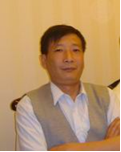|

NAME: JING Yupeng
Degree: Ph. D.
Title: Professor
EDUCATION:
Graduated from Department of Automation Tsinghua University at 1987
Obtained master`s degree and doctor`s degree in Himeji Institute of Technology
RESEARCH INTERESTS:
CMOS and MEMS technology
Study of MEMS/CMOS sensors, RF MEMS, and carbon dioxide supercritical fluid cleaning apparatus
PROFESSIONAL EXPERIENCE:
1987-1992 taught the theory of automation and the design of fire detectors & fire alarm systems at Chinese Armed Police Technology College
1992-1996 undertook the design of safety systems against fire in Committee of Xian government
1996-2003 went to Japan, and obtained master`s degree and doctor`s degree in Himeji Institute of Technology
In 2003, he joined in the RF MEMS Group set up by Fujitsu Akashi Institute Japan,and took charge in the study of electrostatic variable capacitors and electrostatic RF MEMS switches.
2005-present mainly takes part in the study of MEMS/CMOS sensors, RF MEMS, and carbon dioxide supercritical fluid cleaning apparatus in Institute of Microelectronics Chinese Academy of Science
In the period of studying in Japan, he appraised the effects of carbon dioxide in the anisotropic etching rate of crystalline silicon, and confirmed that carbonate ions are the key factors which led to the etching velocity change of (100) planes and (110) planes. He is the first one who found iodine, a kind of neutral oxidant, has perfect effects of eliminating air bubbles and polishing (110) planes in the procession of wet etching. He studied the micro-metal-oxide-sensor arrays on silicon surface utilizing the technology of anisotropic etching of crystalline silicon in Technology Research institute of Osaka Prefecture Japan. The devices are adiabatic structures etched by TMAH, which is a generally accepted wet etching material compatible with CMOS technology. The sensors are widely accepted as a classic combination of CMOS and MEMS production in the world.
|











